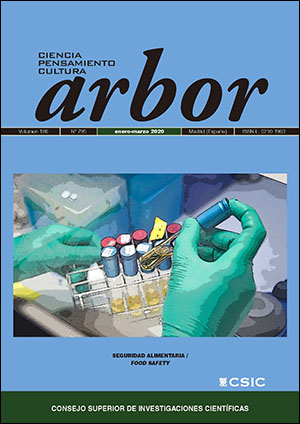Microbiological criteria: principles for their establishment and application in food safety
DOI:
https://doi.org/10.3989/arbor.2020.795n1001Keywords:
microbial contamination, risk-based metrics, sampling plans, risk management, microbiological limit, acceptance probabilityAbstract
Legislation on food safety has led to the standardisation of food production which, together with existing quality certifications, aim to increase the level for protection of public health. The need is recognized for the agri-food industry to have tools to harmonize their production and to adequately manage their quality systems in order to increase consumers’ confidence. The implementation of microbiological criteria is focused on facilitating this harmonization by enabling differentiation of defective lots and acting as control tools at the industrial level. Therefore, knowledge on the principles, components and factors influencing the efficiency of microbiological criteria may be helpful to better understand the consequences of their application. In the present paper the main principles, methodologies and applications of microbiological criteria in foods are addressed for their implementation as part of management quality systems in agri-food industries. In addition, potential limitations and impacts of microbiological criteria on food safety are discussed.
Downloads
References
Bassett, J., Jackson, T., Jewell, K., Jongenburger, I y Zwietering, M. H. (2010). Impact of Microbial Distributions on Food Safety. International Life Science Institute (ILSI).
EFSA Panel on Biological Hazards (BIOHAZ), Ricci, A., Allende, A., Bolton, D., Chemaly, M., Davies, R., Fernández Escámez, P. S. […] y Nørrung, B. (2017). Guidance on the development of microbiological criteria. EFSA Journal 15 (11), e05052. https://doi.org/10.2903/j.efsa.2017.5052 PMid:32625345
International Commission on Microbiological Specifications for Foods (ICMSF) (2002). Microorganisms in Foods 7. Microbiological testing in food safety management. New York: Kluwer Academic/Plenum Publisher.
Schothorst, M. van, Zwietering, M. H., Ross, T., Buchanan, R. L. y Cole, M. B. (2009). Relating microbiological criteria to food safety objectives and performance objectives. Food Control, 20 (11), pp. 967-979. https://doi.org/10.1016/j.foodcont.2008.11.005
Stringer, M. (2005). Summary report. Food Safety Objectives - role in microbiological food safety management. Food Control, 16 (9), pp. 775-794. https://doi.org/10.1016/j.foodcont.2004.10.018
Valero, A. (2015). Predictive tools and strategies for establishing risk-based microbiological criteria in foods. En Sanchís, V., Liébana, E., Romagosa, I. y López Francos, A. (eds.) Food Safety Challenges for Mediterranean Products. Zaragoza: CIHEAM, pp. 67-74.
World Health Organization / Food and Agriculture Organization of the United Nations (2006). Food Safety Risk Analysis: A Guide for National Food Safety Authorities. FAO Food and Nutrition Paper 87. Disponible en https://apps.who.int/iris/bitstream/handle/10665/43718/9789251056042_ eng.pdf
World Health Organization / Food and Agriculture Organization of the United Nations (2016). Statistical aspects of microbiological criteria related to foods. A risk managers guide. Microbiological Risk Assessment Series, 24. Disponible en https://apps.who.int/iris/bitstream/hand le/10665/249531/9789241565318- eng.pdf
Zwietering, M. H., Gorris, L. G. M. y Farber, J. M. (2015). Operationalising a performance objective with a microbiological criterion using a risk-based approach. Food Control, 58, pp. 33- 42. https://doi.org/10.1016/j.foodcont.2014.07.042
Recursos en línea
Codex Alimentarius Commission. CAC/GL 50-2004. Directrices generales sobre muestreo. [En línea]. Disponible en: http://www.fao.org/input/download/standards/10141/CXG_050s.pdf
Codex Alimentarius Commission. CAC/GL 62-2007. Working principles for risk analysis for food safety for application by governments. [En línea]. Disponible en: http://www.fao.org/input/download/standards/10751/CXG_062e.pdf
Commission Regulation (EC) No 178/2002 of the European Parliament and of the Council of 28 January 2002 laying down the general principles and requirements of food law, establishing the European Food Safety Authority and laying down procedures in matters of food safety. Official Journal of European Union L 31, pp. 1-24. [En línea]. Disponible en: http://data.europa.eu/eli/reg/2002/178/oj
Commission Regulation (EC) No 852/2004 of the European Parliament and of the Council of 29 April 2004 on the hygiene of foodstuffs. Official Journal of European Union, L 226, pp. 3-21. [En línea]. Disponible en: http://data.europa.eu/eli/reg/2004/852/2009-04-20
Commission Regulation (EC) No 1441/2007 of 5 December 2007 amending Regulation (EC) No 2073/2005 on microbiological criteria for foodstuffs. Official Journal of European Union L 322, pp. 12-29. [En línea]. Disponible en: http://data.europa.eu/eli/reg/2007/1441/oj
Published
How to Cite
Issue
Section
License
Copyright (c) 2020 Consejo Superior de Investigaciones Científicas (CSIC)

This work is licensed under a Creative Commons Attribution 4.0 International License.
© CSIC. Manuscripts published in both the printed and online versions of this Journal are the property of Consejo Superior de Investigaciones Científicas, and quoting this source is a requirement for any partial or full reproduction.
All contents of this electronic edition, except where otherwise noted, are distributed under a “Creative Commons Attribution 4.0 International” (CC BY 4.0) License. You may read the basic information and the legal text of the license. The indication of the CC BY 4.0 License must be expressly stated in this way when necessary.
Self-archiving in repositories, personal webpages or similar, of any version other than the published by the Editor, is not allowed.














